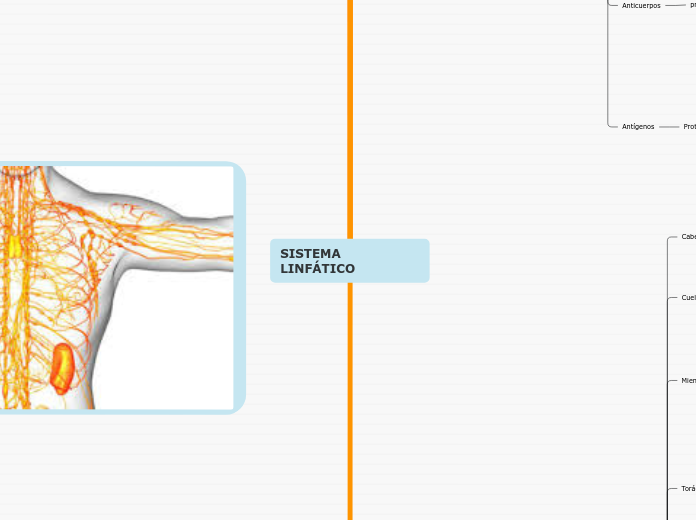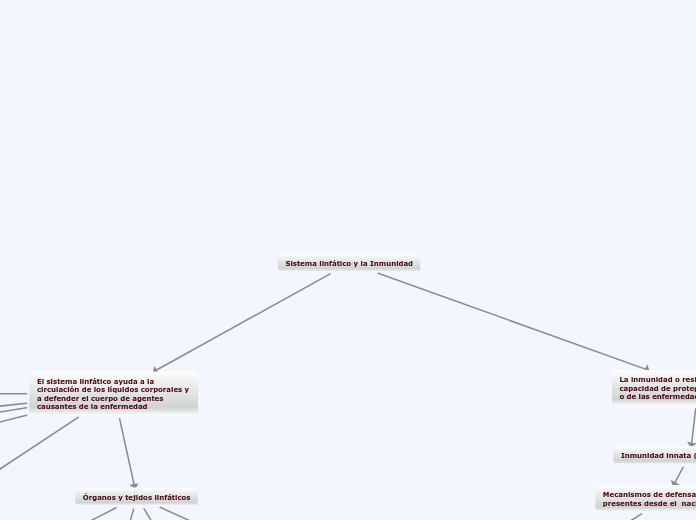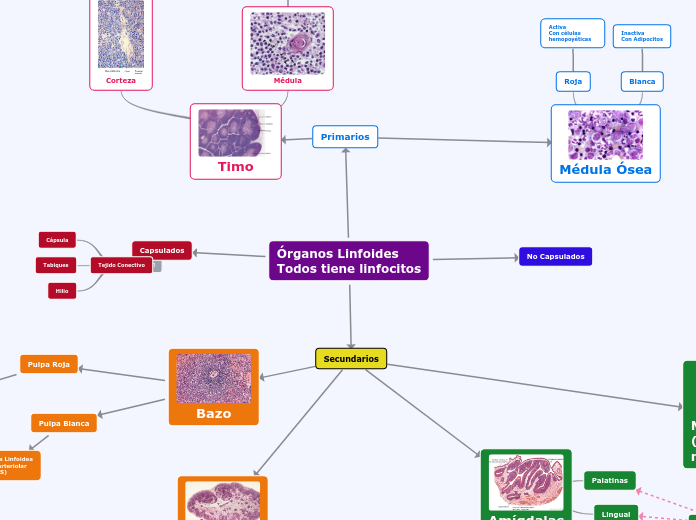SISTEMA LINFÁTICO
Órganos linfoides
Timo
Parte superior y anterior del tórax
2 lóbulos
Lobulillos de tejido linfoide
Elabora
Timopoyetina desarrolla los linfocitos T.
Factor timico.
Factor tímico humoral.
Hormona timosina.
Placas de Peyer
Tejido linfático del intestino
íleon
Submucosa
Folículo primario.
Mucosa
Linfocitos intraepiteliales y epitelio especializado.
Células M
Lámina propia.
Médula ósea
Tejido esponjos de los huesos planos y epífisis de los huesos largos.
Células madre
Hemocitoblasto
Líneas celulares.
Forma la sangre
Plaquetas.
Globulos blancos.
Globulos rojos.
Bazo
Funciones
Inmunológica
Detecta todos los antígenos que ingresan en el cuerpo.
Almacena sangre.
Hematopoyesis
Fagocita bacterias, parásitos y virus.
Destruye globulos rojos viejos.
Forma globulos rojos vida fetal.
Linfopoyesis
Elabora linfocitos.
Inervación
Plexo solar.
Vascularización
Arteria esplénica.
Pulpa roja
Cordones de la pulpa.
Red de fibras reticulares tapizadas por células reticuloendoterial.
Sinusoides venosos.
Pulpa blanca
Tejido linfático.
Trabécula.
Vaina linfática periarterial.
Corteza.
Centro germinal.
Cubierto por cápsula fibromuscular.
2 epiplones
Pancreático esplénico
Vasos esplénicos y cola del Páncreas.
Gastroesplénico
Vasos cortos del estómago.
Estructura mas grande del tejido linfoide.
Localizado parte superior, posterior e izquierda del abdomen.
Amígdalas
Forman anillo de Waldeyer.
Linguales
Base de la lengua.
Palatinas
Propiamente dichas.
Amígadalas faríngeas
Adenoides.
Distribución ganglionar por regiones
Gran vena linfática derecha
Conducto linfático derecho
Desemboca en el confluente yugulosubclavio derecho.
Pulmón derecho.
Corazón.
Lado derecho del Tórax.
Miembro superior derecho.
Cuello lado derecho.
Lado derecho de la cabeza.
Mide 15 cm.
Conducto torácico
Cisterna de Peequet
Recibe linfa
Desemboca en el confluente yugulosubclavio izquierdo.
Miembros inferiores.
Región del abdomen.
Miembro superior izquierdo.
Tórax.
Cuello lado izquierdo.
Lado izquierdo de la cabeza.
Mide 45 cm.
Abdomen
Poplíteos
Detrás de la rodilla.
Inguinales
Profundos.
Superficiales.
Ganglios viscerales
Mesentéricos inferiores.
Mesocólicos.
Ileocólicos.
Mesentéricos superiores.
Pancreáticos.
Hepáticos.
Gástricos.
Ganglios de la pared abdominal
Lumbares.
Sacros.
Ilíacos externos.
Ilíacos comunes.
Torácicos
Gran vena linfática.
Traqueobronquiales.
Intercostales.
Mediastinales anteriores y posteriores.
Miembros superiores
Intermamarios
Recorrido de la arteria mamaria externa, centrales, supraclaviculares.
Subescapulares o mamarios externos.
Interpectorales.
Braquiales.
Deltopectorales
Cubital y anterior.
Axilar.
Región anterior del hombro.
Cuello
Cervical superficial y profunda.
Submaxilar.
Cabeza
Retroauricular.
Occipital.
Parótida superficial y profunda.
Mentoniana.
Geniana.
Función de los ganglios
Antígenos
Proteína extraña
Provoca una reacción inmunológica.
Anticuerpos
proteínas en respuesta a antígenos
Inmunoglobulinas
Inmunoglobulina E
Procesos alérgicos y parasitarios.
Inmunoglobulina D
Formación de receptores en el linfocito B.
Inmunoglobulina M
Enfermedades agudas y fija el complemento.
Inmunoglobulina A
Secreciones mucosas.
Inmunoglobulina G
Procesos crónicos.
cadenas pesadas
Epsilon
Miu
Gama
zona intermedia
Gozne o bisagra
Porción FC.
Porción FAB.
Beta.
Alfa.
Cadenas livianas
Lambda.
Kappa.
Linfocitos B
Célula plasmatica
Elaboran los anticuerpos que van a destruir a los antígenos.
Linfocito B memoria.
Linfocitos T
Memoria.
Supresores.
Citotóxicos o CD 8.
Colaboradores o CD4.
Contienen en su interior linfocitos T y B
Linfocito B
Inmunidad humoral.
Linfocito T
Inmunidad celular.
Células cancerosas.
Antígenos extraños.
Filtran bacterias.
Ganglios linfáticos
Senos medulares espacio que queda entre cuerdas medulares.
Médula
zona interna del ganglio
hileras de linfocitos (cuerdas medulares).
Seno cortical
Macrófagos que fagocitan las bacterias.
Centro germinal
Forma linfocitos.
Corteza
rodea el centro germinal
nódulos linfáticos
masas de linfocitos muy unidos.
Zona subscapsular
debajo de la cápsula
periférico.
Cápsula
cubre al ganglio y forma trabéculas.
Vasos linfáticos eferentes
sale la linfa del ganglio.
Vasos linfáticos aferentes
traen linfa hacia el ganglio.
Tamaño de 2 a 3 cm de ancho 1 cm de espesor.
Congregados en regiones flexoras (axila, cuello, ingle, codo anterior).
Situados a puestos de control o estacionamientos a lo largo del recorrido de los vasos linfáticos.
Características de la linfa
Gran cantidad de valvas en el interior de vasos linfáticos.
Gran cantidad de urea.
Gran cantidad de globulos blancos linfocitos.
No poseer globulos rojos.
Menor cantidad de proteínas, sales, lípidos, fibrinógeno, oxígeno.
Dirección
Va de abajo hacia arriba
Confluente yugulosubclavio derecho
Vena linfática.
Confluente yugulosubclavio izquierdo
Conducto torácico.
Torrente venoso circulación mayor.
Cisterna de Pecquet o del Quilo.
Sale por los vasos eferentes, ganglios linfáticos, grandes conductos, Torácico y Gran vena linfática, drena a la circulación mayor.
Penetra los vasos aferentes, senos corticales, senos medulares.
Estructura
In the beginning of the story (or the exposition), you will need to introduce the setting and characters. You might also want to introduce the main conflict. This part of the story is important because it gives the reader necessary background information and maybe even a first insight into a character’s personality.
Contenido de la linfa.
The setting (time & place) of a story can change throughout the plot.
La linfa que ingresa a los linfáticos
Sensory details include sight, sound, touch, smell, and taste. These details are important because they create depth in your setting.
See a few examples below:
- the smell of fresh bread
- the scent of freshly cut grass
- rain falling onto the windshield etc.
Vascular.
La linfa rodea los tejidos se llama
The weather is an important element in your story because it can highly influence the ambiance and the mood of the characters.
Extracelular.
Intercelular.
The most affected character is the main character. Write down here if he/she is affected by these weather conditions in any way. For example, if they lost a family member or their home during a hurricane, etc.
Tisular.
Decide if you want to include an element of nature in your story. For example, a rainbow can be a very nice choice for a happy ending. The mist in a story can represent mystery and secrets. A thunder can appear in the background at the moment when the 'bad guy' of the story makes its appearance, etc.
Intersticial.
Does your story include catastrophic weather? See a few suggestions below or add your own:
- hurricane, earthquake, storm, etc
Globulos blancos por diapédesis.
The time of the story can also change. It can describe the event of a single day or can include an entire year's plot. Anyway, don't forget to mention it.
Plasma.
Your story can take place wherever your imagination will take you to.
For example: in an elevator, in an enchanted forest, etc. Don't forget to give details of the environment each time the setting changes, otherwise, the story can be confusing. Also, mention the seasons as each of them has unique weather and events.
La linfa se vierte en el sistema venoso circulación mayor.
Characters are essential to a good story. Usually, the protagonist(s) is/are the most affected by the plot. Introduce a character by focusing on their actions, interests, and occupation, as the physical appearance doesn't make a difference in most cases.
Circulación linfática
Absorbe las grasas da aspecto lechoso.
Vellosidades intestinales (vaso quilífero).
Desde los tejidos e intestino.
Formado por
Organos linfoides.
Ganglios linfáticos.
Conducto torácico y gran vena linfática.
Vasos linfáticos.
Linfa.
Función de reabsorción
Type in the name of your character.
Partículas mayores intersticiales.
What is your character's main goal?
fight Evilfind lovedefeat his/her enemyrule the worldmake friendstime travelmake an awesome discoveryOther
Líquidos.
Which traits best describe the character's personality? Choose more if necessary:
introvertedloyalkindindependentquick-thinkingadventuresomeidealisticsweet-naturedcalmrisk-takercreativewittystrictfussyweirdclumsyharshaggressivecarelessclingingcowardlycrueldeceitfulimpulsiveOther
Proteínas.
Choose the type of your chacter:
Protagonist (main character)Antagonist (main character's opponent)Flat (stereotypical character)Round (his/ her personality develops throughout the story)Static (doesn't evolve as a person throughout the story)Dynamic (dramatical change in personality)Confidant (the main character trusts him/ her)Foil (contrasting character who enhances the personality of another character)Other









